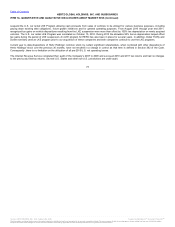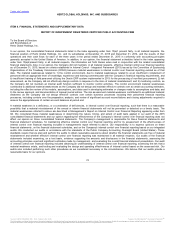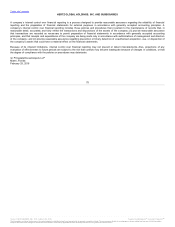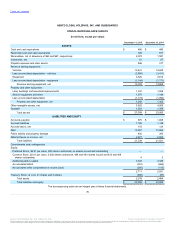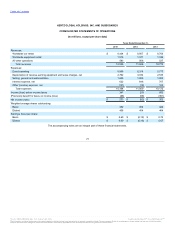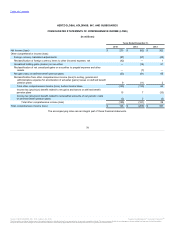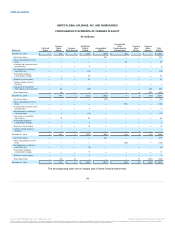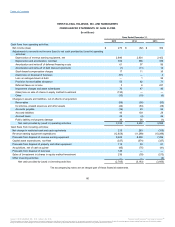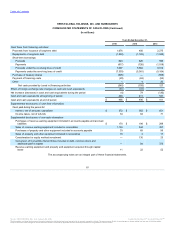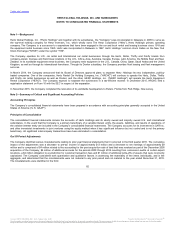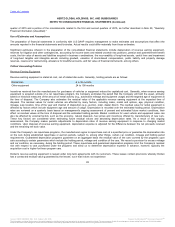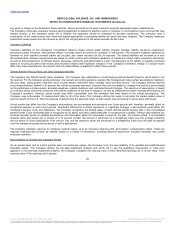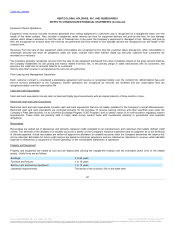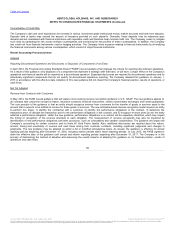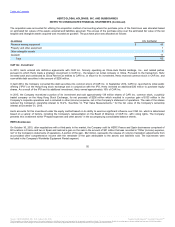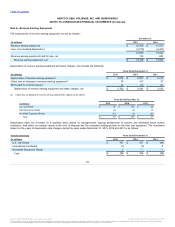Hertz 2015 Annual Report Download - page 91
Download and view the complete annual report
Please find page 91 of the 2015 Hertz annual report below. You can navigate through the pages in the report by either clicking on the pages listed below, or by using the keyword search tool below to find specific information within the annual report.
Table of Contents
quarter of 2015 and a portion of the misstatements related to the first and second quarters of 2015, as further described in Note 20, "Quarterly
Financial Information (Unaudited)."
The preparation of financial statements in conformity with U.S.GAAP requires management to make estimates and assumptions that affect the
amounts reported in the financial statements and footnotes. Actual results could differ materially from those estimates.
Significant estimates inherent in the preparation of the consolidated financial statements include depreciation of revenue earning equipment,
reserves for litigation and other contingencies, accounting for income taxes and related uncertain tax positions, pension and postretirement benefit
costs, the fair value of assets and liabilities acquired in business combinations, the recoverability of long-lived assets, useful lives and impairment
of long-lived tangible and intangible assets including goodwill, valuation of stock-based compensation, public liability and property damage
reserves, reserves for restructuring, allowance for doubtful accounts, and fair value of financial instruments, among others.
Revenue Earning Equipment
Revenue earning equipment is stated at cost, net of related discounts. Generally, holding periods are as follows:
Rental cars 6 to 36 months
Other equipment 24 to 108 months
Incentives received from the manufacturers for purchases of vehicles or equipment reduce the capitalized cost. Generally, when revenue earning
equipment is acquired outside of a car repurchase program, the Company estimates the period that the Company will hold the asset, primarily
based on historical measures of the amount of rental activity (e.g., automobile mileage and equipment usage) and the targeted age of equipment at
the time of disposal. The Company also estimates the residual value of the applicable revenue earning equipment at the expected time of
disposal. The residual values for rental vehicles are affected by many factors, including make, model and options, age, physical condition,
mileage, sale location, time of the year and channel of disposition (e.g., auction, retail, dealer direct). The residual value for rental equipment is
affected by factors which include equipment age and amount of usage. Depreciation is recorded over the estimated holding period. Depreciation
rates are reviewed on a quarterly basis based on management's ongoing assessment of present and estimated future market conditions, their
effect on residual values at the time of disposal and the estimated holding periods. Market conditions for used vehicle and equipment sales can
also be affected by external factors such as the economy, natural disasters, fuel prices and incentives offered by manufacturers of new cars.
These key factors are considered when estimating future residual values and assessing depreciation rates. As a result of this ongoing
assessment, the Company makes periodic adjustments to depreciation rates of revenue earning equipment in response to changing market
conditions. Upon disposal of revenue earning equipment, depreciation expense is adjusted for the difference between the net proceeds received
and the remaining net book value.
Under the Company's car repurchase programs, the manufacturers agree to repurchase cars at a specified price or guarantee the depreciation rate
on the cars during established repurchase or auction periods, subject to, among other things, certain car condition, mileage and holding period
requirements. Guaranteed depreciation programs guarantee on an aggregate basis the residual value of the cars covered by the programs upon
sale according to certain parameters which include the holding period, mileage and condition of the cars. We record a provision for excess mileage
and car condition, as necessary, during the holding period. These repurchase and guaranteed depreciation programs limit the Company's residual
risk with respect to cars purchased under the programs and allow us to determine depreciation expense in advance, however, typically the
acquisition cost is higher for these program cars.
Donlen's revenue earning equipment is leased under long term agreements with its customers. These leases contain provisions whereby Donlen
has a contracted residual value guaranteed by the lessee, such that it does not experience
83
℠
The information contained herein may not be copied, adapted or distributed and is not warranted to be accurate, complete or timely. The user assumes all risks for any damages or losses arising from any use of this information,
except to the extent such damages or losses cannot be limited or excluded by applicable law. Past financial performance is no guarantee of future results.


